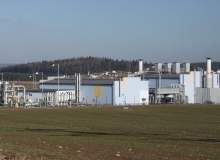
RWE Storage’s Haje underground gas storage (UGS) facility is located near the town of Pribram in the Czech Republic. It is the first UGS unit to be constructed in crystalline structures.
It has the capacity to store 72 million cubic metres of natural gas at a pressure of 12.5 mega pascal (MPa).
Haje is one of the six underground storage facilities operated by RWE in the Czech Republic. It was developed to meet the natural gas requirements of the Prague region during winter.
It also helps to maintain pressure in the pipelines supplying gas to the Prague region. Total investment in developing the facility is estimated at $92m.
Underground gas storage (UGS) facility site location
The geological structure of the Haje reservoir belongs to the granodiorite massif of the Central Bohemian central granite formation.
Storage space was created by drilling and excavating rock from underground. A key feature of the granodiorite massif is that it demonstrated good properties for gas storage and stability of the excavated space.
Construction of RWE Storage’s complex
Development of the Haje UGS commenced in 1992 after conducting detailed engineering and geological investigations. Construction of the facility was carried out between 1995 and 1998.
The Haje reservoir was excavated to a depth of 950m. Natural gas is stored in a series of tunnels with a total length of 45km. The tunnels were formed by drilling and excavating rock.
One tunnel with a slope of 5% was drilled to 961m to 955m depth across a length of 1,350m. Each tunnel has a cross-section of 12 to 15m2. No surface treatment was required for the tunnels.
Support for the tunnels was provided only in areas where rock loosening and risk of tunnel collapse was observed. Permanent bracing was used to provide support. Grout sealing was done in areas where water infiltration occurred.
The UGS facility was sealed from both ends following excavation using two pressure resisting seals made of steel fibre reinforced sprayed concrete. Each pressure seal is a 10m long concrete block and contains four pressure plugs.
A test plug was installed, before the facility was sealed, to obtain information about the type of plugs to be used, the need for grouting works and the impermeability of the rock.
Inert gas was injected into the facility in January 1998 for carrying out tests. First gas for storage was injected in July 1998.
Natural gas is first pre-heated in a heat exchanger and its pressure is reduced compared to that in the facility during the injection. It is then passed through the compressor which compresses and injects the gas into the facility.
Withdrawn gas is passed through a series of separators which remove impurities. Cleaned gas is then passed through compressors and transported to the gas distribution system. Gas withdrawn from the facility is distributed through the Zvestov – Haje pipeline.
Facilities at Haje’s underground gas storage (UGS) complex
The overground part of the facility features gas treatment and transport equipment.
These facilities were installed by January 1996 and include two compressors of 12MW capacity each.
The compressors include gas treatment, metering and control equipment.
The UGS facility is connected to the surface through five production wells.
These wells are used for both gas injection and withdrawal. A draining well is also part of the overground infrastructure.
It is used to pump out any water that has leaked into the facility.
Technology incorporated at the site
Gas is stored in two levels at the facility, with a third level planned in the future. The first level is controlled by actuators and control panels. The second level is monitored through the control room where operators control individual actuators.
Contractors involved to provide services
Dolexpert-Geotechnika provided consulting services for the excavation of the tunnels of the facility.
ProTyS was responsible for modelling the monitoring and early warning system for the facility. UniControls supplied control systems for the facility.



